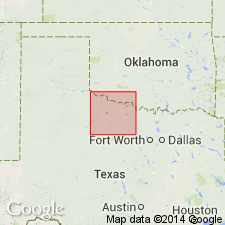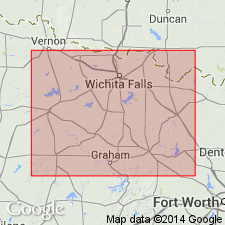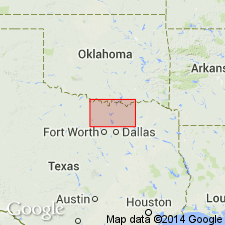
- Usage in publication:
-
- Nocona Formation
- Modifications:
-
- First used
- Dominant lithology:
-
- Mudstone
- Sandstone
- AAPG geologic province:
-
- Palo Duro basin
- Bend arch
- Fort Worth syncline
Summary:
First used as a formation in the lower part of the Wichita Group that is mapped north of Hwy 114 and northeastward across the sheet from Baylor Co to Archer Co, TX (on Bend arch) into Clay Co, TX (on Fort Worth syncline), and Wichita Co, TX (in Palo Duro basin). Neither source of geographic name nor type locality given. In adjacent area to south, the Elm Creek (base), Valera, and Jagger Bend (top) Formations of Albany Group are considered equivalent to the Nocona. Overlies first used Archer City Formation of Bowie Group (first used). Underlies first used Petrolia Formation of the middle part of Wichita Group. Is 280 to 350 ft thick. Thickens northward. Consists predominately of red-brown, locally gray or variegated mudstone that has vertebrate and plant fossils, calcareous nodules. Also includes laminated tan to dark-brown, fine- to very coarse grained, locally conglomeratic sandstone and siltstone in sheets and lentils 1-3 ft thick. Lenticular calcareous-nodule conglomerate common. Of Wolfcamp and Leonard age; series boundary is near top of formation.
Source: GNU records (USGS DDS-6; Denver GNULEX).

- Usage in publication:
-
- Nocona Formation
- Modifications:
-
- Named
- Dominant lithology:
-
- Sandstone
- Mudstone
- Conglomerate
- Siltstone
- AAPG geologic province:
-
- Bend arch
- Fort Worth syncline
- South Oklahoma folded belt
Summary:
Named as lowermost of three new formations of Wichita Group (revised); origin of name probably Nocona, Montague Co, TX. Stratotype designated at river bluff about 3.6 mi north of Ringgold, Montague Co. Overlies Archer City Formation of Bowie Group (both named in this report); underlies Petrolia Formation (named) of Wichita. Nocona consists of all continental strata that are approximately equivalent to Coleman Junction Formation (revised) and Admiral Formation (revised) of Albany Group. Present in extreme southeastern Baylor Co, and Archer, Clay, and northern Montague Cos, TX on Bend arch and Fort Worth syncline. Contacts were traced a short distance northward into Jefferson Co, OK in S. Oklahoma folded belt province. Nocona has 11 sandstone members (ss1-ss11). At stratotype the river bluff is supported by sandstone member ss11 and comprises about 46 ft of reddish-brown mudstone and very coarse grained and granular sandstone. Lower two unmapped sandstone bodies are superimposed locally, which is common in the eastern part of outcrop. Thickens to northeast from 280-350 ft. There is regional variation in grain size and sandstone composition. Chert-pebble conglomerates are restricted to eastern part of outcrop. Associated sandstones are coarse-grained and granular; contain chert fragments. In western part of outcrop very fine and fine sandstones predominate. Is of Early Permian (Wolfcampian) age. Geologic map.
Source: GNU records (USGS DDS-6; Denver GNULEX).

- Usage in publication:
-
- Nocona Formation
- Modifications:
-
- Mapped 1:250k
- Dominant lithology:
-
- Mudstone
- Sandstone
- Siltstone
- Conglomerate
- AAPG geologic province:
-
- Fort Worth syncline
- South Oklahoma folded belt
Summary:
Pamphlet [p. 8]. Nocona Formation of Wichita Group. Mudstone, sandstone, siltstone, and conglomerate. Mudstone, reddish-brown, yellowish-brown, locally gray and olive, unstratified and thick-bedded, calcareous nodules and ferruginous concretions locally common; sandstone and siltstone in lentils and platy thin beds throughout, laminated, cross-laminated, cross-bedded.
Sandstones and conglomerates (descending, ss11, ss6, ss5, ss4, ss3, ss2, and ss1, separately mapped); sandstone in broad channel-fill bodies, tan to dark-reddish-brown, fine-grained to very coarse-grained, thin- to thick-bedded, soft-sediment deformation typical in thicker beds, large-scale crossbeds common, friable to moderately well cemented with silica, limonite, and hematite; chert-pebble conglomerate mostly near base of thicker units; individual members locally exhibit multi-story configuration of beds; thickness of sandstone members 5 to 40 feet.
Thickness of formation 330 to 350 feet. Lies above Archer Formation and below Petrolia Formation; both of Wichita Group. Age is Early Permian; Leonard-Wolfcamp boundary located approximately at or near base of ss11. [Mapped in northwestern corner of map sheet, in Clay Co., northeastern TX, and Jefferson Co., southeastern OK. Rocks previously (1967 ed. of map) included in "Permian rocks above Graham Formation." See also Hentz, 1988, and adjacent Wichita Falls-Lawton sheet, Texas Geol. Atlas, 1987.]
Source: Publication.
For more information, please contact Nancy Stamm, Geologic Names Committee Secretary.
Asterisk (*) indicates published by U.S. Geological Survey authors.
"No current usage" (†) implies that a name has been abandoned or has fallen into disuse. Former usage and, if known, replacement name given in parentheses ( ).
Slash (/) indicates name conflicts with nomenclatural guidelines (CSN, 1933; ACSN, 1961, 1970; NACSN, 1983, 2005, 2021). May be explained within brackets ([ ]).

